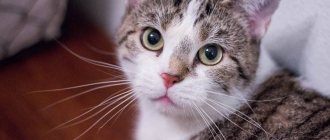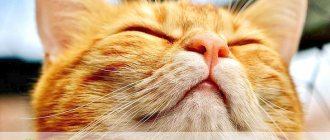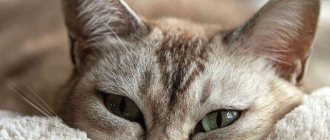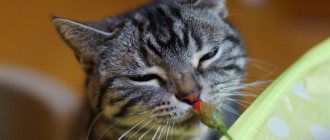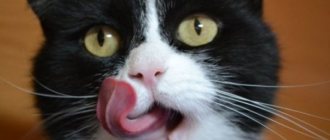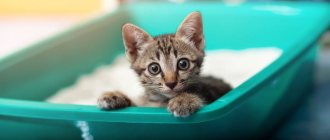11647Administration
Animals, unlike people, do not suffer from common colds. If a cat has snot and watery eyes, this is almost always a sign of a serious illness and a reason to visit the veterinarian. Premature panic will only aggravate the situation, and your task is to analyze the symptoms and find possible causes of the ailment.
Excessive snot from the nose and sore eyes indicate that the cat’s body is trying to heal on its own. The discharge protects the sensitive mucous membrane and prevents the penetration of dust.
Depending on the external appearance of the snot, the doctor can determine the causes of a runny nose in a cat.
The allocations are divided into:
- Transparent and opaque, stretchy or liquid;
- White, yellow, red, gray-green;
- Snot flows continuously or intermittently;
- After leaking, they form crusts or come out freely.
© shutterstock
Concomitant and side symptoms
If you suspect that your kitten is sneezing for some reason, you need to identify side symptoms that will indicate a diagnosis. The difficulty is that at an early stage of development, almost all respiratory, bacterial and viral infections have similar symptoms.
In addition, small kittens do not tolerate cold well, so the cause of sneezing may be hypothermia.
The kitten's eyes are watering
Practice shows that most often sneezing in kittens with a clinical complication is caused by the feline herpes virus. Small kittens become infected from adults who have access to free range and catch infected rodents. An infected kitten may be visually healthy until severe stress or another reason causes a weakened immune system.
With the feline herpes virus, the kitten's eyes become watery and there is extensive irritation of the mucous membranes and swelling. After infection, an atypical plaque may appear on the mucous membranes. However, plaque may be a symptom of herpes or a sign of secondary infection.
Note! The feline herpes virus is not dangerous to humans.
Eyes fester
Rhinotracheitis is one of the most common viral diseases in small kittens, especially those living on the street. The nature of the disease is viral, so rhinotracheitis affects the entire population of cats living in a certain area. Theoretically, a kitten can recover from rhinotracheitis without treatment and develop lifelong immunity. However, the surviving animal remains a carrier and infects other cats through airborne droplets or contact.
Important! A kitten that has had rhinotracheitis can live a long, fulfilling life. However, if you decide to adopt another pet (even an adult), it will become ill if it does not receive its initial vaccinations before moving into your home.
The primary symptoms during the development of the clinical picture of rhinotracheitis are very similar to a cold: the kitten sneezes, his eyes are watery, there is apathy, and a slight increase in body temperature.
The virus progresses over several hours or days, leading to a sharp deterioration in the animal’s condition. The kitten's eyes are festering, there is a constant fever, and there is a complete loss of appetite. Purulent masses accumulate in the nasal sinuses, which leads to the ingestion of pus and the development of bacterial damage to the intestines.
With adequate treatment, rhinotracheitis can be stopped, and relief occurs quite quickly. If left untreated, the kitten gets sick for 7–10 days, after which it dies or recovers. A kitten has no chance of recovery if a secondary bacterial or fungal infection develops against the background of rhinotracheitis.
If your kitten has a dry nose
A dry nose, lethargy, high fever, sneezing, discharge from the eyes are a sign of a viral infection.
Calcivirosis is a dangerous, widespread viral infection that causes the death of thousands of stray cats and kittens every year. The disease is manifested by sneezing, profuse nasal discharge and purulent discharge from the eyes.
If left untreated, ulcers appear on the cat's mucous membranes, usually in the mouth. The clinical picture quickly progresses and leads to the development of pneumonia, after which the animal dies.
The kitten is sneezing and snot is flowing
If a kitten sneezes from time to time, has snot running, does not have a fever and does not have a deterioration in appetite, most likely the cause is irritants or allergens.
Observing the kitten's behavior will help determine the diagnosis. He will sneeze every time he gets close to the irritant. Owner experience shows that small kittens often sneeze after using a litter tray and after cleaning the house using chemical cleaning products.
Common irritants that can cause a kitten to sneeze are:
- Dust, pollen.
- Cigarette smoke.
- Perfume, eau de toilette, deodorant.
- Any sprays.
- Fabrics that accumulate dust.
- Almost all cleaning products.
- Aroma candles.
- Mold.
Unlike people, with allergies in cats, swelling of the mucous membranes, nasal discharge and a slight increase in base body temperature are most often observed, but sneezing appears last.
One of the most common symptoms of allergies in cats is itching, in the absence of parasites. To test your hypothesis if it is impossible to contact a veterinarian, the cat must be given an antihistamine in a strictly calculated dosage. If the symptoms go away quickly, the cause is an allergy.
3.What is non-allergic rhinitis and its causes?
What is non-allergic rhinitis?
Non-allergic rhinitis
is a medical term used to describe allergy-like symptoms. But rhinitis is not an allergy, and rhinitis begins for unknown reasons. Symptoms of rhinitis may include:
- Nasal congestion;
- Runny nose;
- Sneezing.
Actually non-allergic rhinitis
– This is a runny nose that is not caused by allergies or a cold. Rhinitis typically develops in adults, and rhinitis symptoms can occur year-round. Unlike allergic rhinitis, non-allergic rhinitis does not affect the immune system. Allergic rhinitis is more common than non-allergic rhinitis, but the problem is still quite common. It can often be difficult to distinguish between allergic and non-allergic rhinitis based on external signs, so it may be necessary to undergo special allergy tests and blood tests to accurately diagnose rhinitis.
Non-allergic rhinitis can cause no less inconvenience than allergies. The appearance of rhinitis may be associated with complications of certain diseases, such as:
- Sinusitis
– inflammation or swelling of the sinuses; - Eustachian tube dysfunction;
- Otitis
is a chronic ear infection; - Asthma;
- Obstructive sleep apnea.
It is often not possible to accurately determine the factors that cause a non-allergic runny nose. And the problem itself is often diagnosed only when other possible health problems - allergies or colds - have been excluded.
Non-allergic rhinitis is most likely to occur due to environmental factors. Some environmental irritants can be encountered at home, others at work or simply in the environment. Examples of what can cause rhinitis symptoms include:
- Exhaust gases from cars;
- Chlorine;
- Cigarette smoke;
- Household chemicals;
- Glue;
- Hair fixation spray;
- Latex;
- Metal salts;
- Perfume;
- Smog;
- Wood dust.
When such triggers cause non-allergic rhinitis, they often cause asthma.
Some medications (such as non-steroidal anti-inflammatory drugs (aspirin, ibuprofen), oral contraceptives, medications for blood pressure problems, antidepressants and tranquilizers, drugs for erectile dysfunction) can cause non-allergic rhinitis.
Foods and drinks can also sometimes cause rhinitis. This particularly applies to hot foods (such as soup), spicy foods, and alcoholic beverages, especially beer and wine.
Other factors that provoke rhinitis may be:
- Drugs
. Chronic nonallergic rhinitis is common in people who use cocaine and other drugs; - Weather changes
. Sudden changes in weather or temperature can cause rhinitis. Chronic runny nose, for example, is common among skiers. And some people suffer from rhinitis during any cold spell. Sometimes sneezing and runny nose begin after leaving a cool room in which the air conditioner was running. - Hormonal changes
. Hormonal imbalance often causes rhinitis. Chronic runny nose in pregnant women, which lasts until childbirth, is not uncommon.
About our clinic Chistye Prudy metro station Medintercom page!
Possible diseases if a kitten sneezes
In addition to the above viral infections, possible diseases that cause sneezing in a kitten can be of a different nature. Unfortunately, the range of diseases is so wide that only a veterinarian can cope with the diagnosis.
The most dangerous are viral diseases, against which the kitten must be vaccinated.
If you pick up a baby on the street or buy it at a poultry market, the resulting viral diseases can cause its death.
Possible diseases of which sneezing may be a symptom are:
- Infectious peritonitis occurs without symptoms for a long time, and at an early stage of the clinical picture it is similar to a cold.
- Feline immunodeficiency virus is a slowly and secretly developing disease that adversely affects the body's immune system. When the cat's immunity level declines, it becomes vulnerable to any, even basic respiratory infections.
- Feline viral leukemia - in the first stages of development, is similar to a respiratory infection, in fact, it is a serious viral disease, which most often leads to death.
- Chlamydia - gives a complete picture of an acute viral respiratory infection complicated by bacterial infection. Unfortunately, chlamydia is highly contagious and common. One of the first symptoms of chlamydia is acute conjunctivitis.
- Mycoplasmosis is common, like chlamydia, contagious, and deadly. Mycoplasmosis progresses more slowly, but leads to more severe consequences: bacterial pneumonia and swelling of the respiratory tract.
Most viral infections cannot be diagnosed with guaranteed accuracy. To detect infection, blood is taken from the cat and examined for the presence of antibodies.
With viral infections, everything is a little more complicated; the causative agents of the disease must be found in the blood sample. This diagnostic method is called PCR. Unfortunately, PCR diagnostics are not available in all clinics and cost a lot of money, so most veterinarians, suspecting a viral infection in a kitten, begin complex, aggressive therapy.
In what cases is a visit to the veterinarian necessary?
You will not be able to handle treatment on your own if your kitten has contracted a viral infection. Your ward can survive if his immunity is strong enough to cope with the infection on his own. However, survival of kittens during viral infection is the exception rather than the rule.
In what cases is a visit to the veterinarian necessary:
- You know that your kitten has been in contact with virus carriers - it was picked up on the street, taken from a shelter, bought at a poultry market and does not have a vaccination document.
- The kitten has severe swelling of the eyes and ulcers on the mucous membranes.
- Against the background of loss of strength and severe depression, fever is observed.
- Constant drooling, copious nasal discharge, purulent discharge from the ears and eyes.
- Weight loss while maintaining appetite or a decisive refusal to eat.
- Enlarged lymph nodes.
- Wheezing or whistling when breathing, cough with or without phlegm.
- Breathing problems.
- Severe problems in the digestive system.
In addition, you should contact a veterinarian if the kitten does not have a severe clinical picture, but the sneezing continues for more than 3-7 days. Some viral infections develop secretly.
Immediately after infection, the kitten exhibits some symptoms, however, the immune system fights them. Under pressure from the immune system, the virus weakens, but remains in the body until the opportunity arises.
The most common reasons
Has your cat started sneezing frequently, has snot and tears flowing from her eyes and are you seriously worried? But this can happen for understandable reasons, for example, if the cat has swallowed dust. Remember the consequences after you try to pepper the soup, or tickle your nose with a feather, then you walk around and sneeze all day. Believe me, not all cats enjoy this.
Kittens and cats sneeze if:
- If you caught a cold - a standard case that causes sneezing, a constant companion in the form of a runny nose is provided;
- They suffer from allergic reactions to various drugs, products and chemicals. In this case, sneezing is a completely understandable reaction of the cat’s body trying to get rid of the allergen;
- There are viral infections in the form of rhinitis, herpes or adenovirus;
- Breathing is complicated by the presence of growths or polyps in the nasopharynx;
- The presence of chronic asthma is another reason for sneezing in a cat;
- The presence of a malignant tumor or formations that make breathing difficult in the nasal cavity;
- The animal suffers from chronic diseases of the teeth or gums;
- Parasites operating in the animal’s body disrupt the natural processes of respiration.
Now let's talk more about allergies in cats. After all, it is often she who becomes the reason for the frequent pronunciation of the phrase: “be healthy, Murzik.”
So, a list of allergens.
- Household chemicals - detergents, cleaning agents, disinfectants, powders, sprays and other products for cleaning the house and outside.
- Cigarettes, or rather smoke, poisoning everything around and making it difficult for your pet to breathe.
- All types of fungi on tiled surfaces. In a word, a paradise for the proliferation of all kinds of bacteria and lack of hygiene in one bottle. Cats don't like this at all.
- If you use perfume or eau de toilette, or hairspray, remember to do this in a ventilated room. Another reason for the development of allergies in cats.
- Spray products that we use to kill mosquitoes, flies and other insects in the summer will also not add health to your cat.
- And the reason that completes this hit parade is pollen and flowering plants, which cannot be avoided in the spring and summer.
All of the above, as a rule, leads to the development of allergies in a cat, as it irritates the mucous membrane and causes a flurry of snot and makes the cat constantly sneeze, causing inconvenience to you and the animal.
How to diagnose the disease yourself?
As a rule, any organism strives for self-healing; this is inherent in the nature of any creature, including cats. Therefore, symptoms in the form of a runny nose are quite normal, they are simply freed from dust particles, foreign bodies and other nasties. With the help of observations and simple actions, we can independently understand the nature of the disease that has overtaken our pet.
A cat's refusal to eat and constant attempts to rub its nose indicate a runny nose and a cold. In this case, everything will work out if you take action in time.
Identifying an eye infection is also quite easy. Its symptoms are an increased sneeze reflex and watery eyes. There may be reasons for this. It's not difficult to figure them out. The main thing is not to consider this as the norm. This is a more serious disease, and accordingly the treatment method will be different.
Our curious little pets have the ability to climb into any jar, smell, taste, lick. Unfortunately, this can lead to more severe allergies. Be vigilant and try to remove all dangerous materials. If everything has already happened, find this remedy and act according to the situation.
Foreign objects caught in the nasopharynx will haunt the cat. He will do his best to try to get rid of it through snorting and intensive nose scratching.
But combined with bad breath, swollen gums and purulent processes, this is a rather unpleasant signal and a visit to the dentist will be very necessary. Long-haired cats may have watery eyes from their own fur.
As a rule, discharge comes in different colors and indicates different symptoms, causes and diseases. Green or gray snot when sneezing indicates the presence of a fungus or infection in the body. Colorless discharge combined with watery eyes indicates the presence of an allergy.
It is not always possible to identify diseases such as asthma on your own. But if this is so, then irritants and all unpleasant odors must be eliminated from the home or pet’s habitat.
Treatment of sneezing
So, if your baby or cat has a runny nose and starts sneezing, drops prescribed by the doctor will come to your aid. They will fight all bacteria, and soon your cat will regain peace of mind and health. Just drip into food until symptoms disappear.
In most cases, foreign objects can be removed from the nose on your own. But if you are not confident in your own abilities, hand the animal over to specialists, they will do everything right. If the foreign body is a nasal tumor, immediately hospitalize your pet; he needs surgery.
If a dental examination gives disappointing results in the form of problems with teeth, gums or inflammation, then you know which doctor can help in this case. After all procedures, symptoms should stop.
Allergy to mold is treated by eliminating this very mold and various ointments for external use. Remember, excluding the external irritant from the cat’s environment will reduce the allergy to nothing. If the whole point is an infection, then preparations based on natural plants will help you.
Remember, care, care and compliance, following all doctor’s orders and observing basic hygiene rules can work wonders. Wash your hands after and before handling the cat, and dry your eyes with a clean towel. If your condition worsens, contact the clinic for help.
How to treat at home?
If you decide to treat your cat at home, then remember that this should be done based on the cause of the disease:
- Worms can be cured with special medications. Including Bothionol and Phenothiazine.
- Lysine is effective against sneezing caused by herpes.
- Mold allergies are treated with special ointments.
- If the cause is dental, the doctor will give the necessary recommendations and prescribe medications.
- Keeping your cat away from the source of your allergy, keeping your home clean, and monitoring your cat's activities will be an effective way to combat allergies.
Why does rhinitis occur in cats?
The common cold is a disease that cats usually do not get. But at the same time, it is not uncommon for the owner to notice that the pet is sneezing, his eyes begin to water and real rhinitis appears. Cats are susceptible to it quite often due to a physiological feature - a very narrow nasal passage. Even slight swelling can lead to nasal congestion.
There are a number of reasons that can cause a runny nose in a pet:
- Damage to the nasal mucosa by bacteria or fungal infections. They can be a serious threat to your pet's health, or they may not harm him. It all depends on their type and quantity in the body. A slow infection causes a chronic runny nose, and an aggressive fungus can lead to complete blockage of the nasal passages, to the point where the pet cannot breathe. How to treat in this case depends on the diagnosed infection.
- The virus can also cause a runny nose. They can be serious, and it is impossible to cure them without a visit to the veterinarian - such a method as treating them at home with folk remedies can lead to the loss of your pet.
- Allergies can cause a runny nose. Animals, just like people, suffer from allergic reactions. The reason could be anything: litter, a new collar, unusual food, the owner’s cosmetics, cleaning products, etc.
- Illness and decreased immunity can also cause rhinitis.
- Hypothermia and ear inflammation can cause snot in your pet.
- A tumor can cause rhinitis. Its signs will be snot with blood.
- Pathology of the nasopharynx and the entry of foreign parts into it is accompanied by a runny nose.
- Snot can also be caused by a parasite - worms or fleas.
Depending on the causes of rhinitis, it is divided into primary and secondary. Primary appears due to hypothermia, inhalation of irritants. The cause of the secondary is infection, the presence of parasites or foreign bodies in the body.
How to find out why your cat has a runny nose?
At the veterinary clinic, the doctor will tell you the causes of the disease and prescribe treatment after a series of measures:
- Examination of a sick animal, which includes: examination of the mouth and throat, measuring temperature, palpating the lymph nodes and abdomen of the cat.
- Studying the history of the disease from the owner’s words: when the cat got sick, how the illness began, how many days it has been sick, how it behaves, etc.
- Conducting general and biochemical blood tests and urine tests.
- If necessary, your doctor may recommend a swab of your cat's nose or throat.
- If the veterinarian suspects the presence of polyps or a malignant neoplasm in the nose, an endoscopy of the nasal passages or an X-ray of the head will be necessary for an accurate diagnosis.
After all the results are received, the veterinarian will give an exact answer to the question: “Why is the cat sneezing and his eyes watering?”
How to determine if your pet is sick
As you can see, a runny nose can be the cause of a more serious illness. Of course, only a veterinarian can make an accurate diagnosis, who will also explain how to cure a runny nose in a cat. The owner is required to carefully monitor his pet. The sooner he notices the problem, the greater the chance of preventing or quickly curing the disease. Let's look at the main symptoms that will help you suspect that something is wrong with your pet:
- the animal is breathing heavily or breathing through its mouth;
- the cat sneezes and looks sick;
- mucus is released from the nose, the animal rubs or scratches its nose;
- the temperature rises, the nose becomes warm;
- your pet has a “watery look” - a runny nose may be accompanied by conjunctivitis;
Usually rhinitis is an attempt by the body to heal. The secretions wash away dust, particles and everything unnecessary from the mucous membrane, moisturize it, preventing drying and irritation. What to do if your pet has a cold and all the symptoms are present? Treatment at home is possible only after consulting a specialist.
How to treat a runny nose in a cat? To begin with, the owner needs to observe what type of discharge from the pet’s nose is clear or colored, thick or liquid, viscous, copious. It is also necessary to understand whether the animal’s snot occurs constantly or at a certain time (for example, in the morning, in the evening or during periods of activity). Are there any additional problems: sneezing, watery eyes, wheezing. This will help determine the cause of the runny nose.
Let's look at the main symptoms:
- Allergic rhinitis: nose stuffy, snot running, eyes swollen, possible suppuration, itching. The first method of treatment in this case is to identify and remove the irritant (allergen).
- Virus: the cat refuses to eat, there is vomiting, snot, the eyes begin to water, and suppuration may appear.
- If an animal shows that something is bothering him in his nose (for example, he rubs his nose with his paw), asymmetry has appeared on his face - there may be a tumor or polyps.
- Snot, the cat shakes its muzzle and sneezes are a sign of the presence of a foreign body.
Features of treatment
What to do if your cat has a runny nose and watery eyes? It is imperative that you take your pet to a doctor. Only he can determine the causes of the disease and explain how to treat it.
Treatment for a runny nose in cats depends on what type of rhinitis is diagnosed. If this is a consequence of a bacterial infection, the pet is prescribed a course of antibiotics. You should take the medications before the end of the course, otherwise the infection may return and chronic rhinitis will appear.
For severe nasal congestion, your veterinarian may prescribe drops for a runny nose. These are vasoconstrictor drugs with an immunostimulating effect. However, you shouldn't overdo it with them. Typically, drops for a runny nose are used for 7 days.
There is also a three-step method for treating a runny nose:
- veterinarians recommend the drug Diocyclin. On the first day you need to give the cat 1/5 of a tablet for every kilogram of weight. From the next day, the dosage should be reduced to 1/10 part per kg. The drug is given for 14 days.
- the next step is Fosprenil. Dosage: 0.2-0.5 parts per kilogram.
- You can also dilute Dioxidin with Naphthyzin for children in equal proportions. Inject the resulting product into the nostril 3-5 times a day.
Traditional methods
An owner who is wondering how to cure a runny nose in a cat will also find folk methods useful. It is advisable to use them after discussion with your doctor. You can treat an animal with the following folk remedies:
- Warming up (you can use heated salt in a bag and apply it to the spout)
- Rinsing (solutions of soda or salt are taken into a syringe (without a needle) and injected slowly into the nostrils)
- Instillation (use beet juice for this)
The owner should prepare for the fact that treatment at home will be long, but not difficult.
When an animal has a cold, it becomes indifferent to food: and not surprisingly, due to a stuffy nose, it does not hear odors. The owner’s task is to stimulate the pet’s appetite so that the pet does not lose strength. Use food with a pronounced aroma, offer your pet his favorite dish, fish or canned food. You can use a trick and smear food on your pet’s nose - in this case, he will have no choice but to lick himself. Cleanliness will play a role. Perhaps the pet, licking itself, will taste the goodies.
Preventing runny nose in pets
To eliminate most causes of runny nose in cats, you need to:
- limit your pet’s contact with stray animals;
- exclude access to potential allergens;
- provide the animal with a warm, dry resting place without drafts;
- do not neglect vaccination and deworming;
- support your pet’s immunity and take care of its proper nutrition.
It is quite possible to cure a runny nose in a cat on your own, but only after mandatory consultation with a doctor. If treated promptly, a specialist can identify the cause of an animal’s nasal discharge and prescribe appropriate therapy. A caring and responsible owner should closely monitor any changes in the animal’s behavior - therapy for pathology identified at an early stage will be simple and most effective.
Prevention methods
It is important to know not only how to treat acute and chronic runny nose in a cat, but also how to prevent it. How to make sure that your pet does not suffer from a stuffy nose and avoids colds?
The first rule is a good diet. In order for a cat to have strong immunity and health, he must receive all the necessary elements with food.
The second rule is comfortable conditions. The animal should not be in the cold or drafts. The pet must be vaccinated and undergo regular checkups with a doctor.
Cats are prone to allergic reactions, so you shouldn’t “test” their mucous membranes “for strength.” Do not use cosmetics or spray various chemicals (including cleaning agents) near the animal. If you notice that your animal’s eyes begin to water next to some household chemical item, isolate this item.
Make sure your pet doesn't catch the virus. Even an indoor cat that doesn't go outside can become infected. Causes: a virus or infection contracted on shoes or clothing. Therefore, it is advisable to keep your pet away from dirty shoes and wash your hands upon arrival home.
When engaging in self-treatment, you should always understand that an untreated cold can come back again and become chronic. In this case, it will be much more difficult to get rid of it. Therefore, the owner needs to be responsible for his pet: observe his behavior, notice various changes and, if necessary, be sure to seek professional help. Remember: if your treatment method does not help, and the animal’s runny nose lasts more than 5 days, this is a bell indicating that it is time to see a veterinarian.
We hope that now the owners know the answer to this question, what to do if the cat has a runny nose.
Treatment of runny nose in cats
If you notice snot in a cat, you should watch your pet. Many serious pathologies, one of the manifestations of which is a runny nose, are accompanied by other unpleasant symptoms - the owner will have to talk about them during a visit to the doctor. Only a specialist can find out the cause of rhinitis.
Self-therapy is fraught with negative consequences - the use of certain drugs can hide the symptom of a serious pathology, and time will be lost, because most diseases are successfully treated if detected at an early stage.
Traditional methods of treating a runny nose
If the animal’s behavior has not changed - it is playful and does not refuse food, then before visiting the veterinarian you can relieve a runny nose using folk methods:
- inhalation with eucalyptus: an infusion of 15 g of herb and 200 ml of boiling water is used - it is prepared within 30 minutes; for inhalation, you can use a teapot; before the procedure, the pet should be wrapped in a towel and sat down so that the spout of the teapot is in close proximity to the animal’s face, and care must be taken to ensure that the pet does not get burned;
- applying a bag of warm sand or salt: the procedure may be accompanied by copious discharge, which must be removed with a previously prepared disc or cotton swab;
- rinsing with saline solution: the liquid is injected carefully using a syringe without a needle - 0.5 ml is enough for each nostril; Before starting manipulations, the animal must be wrapped in a diaper or piece of cloth.
Video: treating a kitten for a runny nose with folk remedies
Treatment of a runny nose in a cat with medications
After determining the cause of a runny nose in a pet, a specialist will prescribe appropriate therapy. If a runny nose is one of the signs of an infectious disease, then you cannot do without an antibiotic. Frequently prescribed drugs in this group include Amoxiclav and Baytril. For mycoplasmosis and chlamydia, tetracycline drugs are prescribed, and for bordetellosis, Ciprofloxacin is indicated. Neotim, Vitafel, Giscan are used in the treatment of viral infections. The duration of treatment and dosage of drugs is determined by a specialist.
Drops are used to relieve congestion. Special products for animals, sold in veterinary pharmacies, not only relieve congestion, but also have an immunomodulatory effect. These include:
- Anandin - dosage - 2-3 drops in each nasal passage, up to three times a day;
- Maxidin - dosage - 1-2 drops in each nasal passage, 2-3 times a day;
Drops for cats relieve nasal congestion
- Thymogen - 1-2 drops in each nasal passage, once a day, is enough.
To ease breathing in cats, you can use children's Naphthyzin with Dioxidin in a 1:1 ratio - 1-2 drops in each nasal passage. Before instilling drops, remove crusts near the nose. To do this, they need to be softened with Vaseline oil.
You need to be careful when dripping into your cat's nose.
If the nature of nasal discharge is allergic, therapy with antihistamines will be required. The most effective and harmless anti-allergy drugs are Zyrtec and Fexofenadine.
It is better to entrust the removal of a foreign body from the nasal passage to a veterinarian. Manipulations are carried out under local anesthesia; in particularly severe cases, surgery is necessary. Surgical intervention cannot be avoided even in the presence of polyps.
Features of kitten therapy
Treatment of small pets is practically no different from treatment of adult animals. For furry babies, the specialist prescribes medications approved for use in kittens. To ease breathing, the following can be used: Aquamaris, children's Pinosol, Protargol, inhalations. There are no contraindications for Anandin drops either. Antibiotics acceptable for use in small pets include Vilprafen.
Diseases that cause sneezing and nasal discharge in cats
Let's look at the most common ailments that can cause your pet cat to sneeze frequently and have snot:
- Colds are perhaps one of the most common reasons why a cat sneezes and has snot. Like their owners, cats can catch colds as a result of contact with sick relatives, as well as due to a decrease in immunity caused by hypothermia.
- Allergic reactions. They can be caused by various substances that have a strong odor, for example, household chemicals or the perfume of the animal's owners. Sometimes the allergen can be tobacco smoke, pollen, house dust or even the fur of other animals.
- Various viral infections. The reason why a cat is periodically bothered by snot and sneezing may be an evil virus, for example, adenovirus or herpes.
- Eye infections such as conjunctivitis and keratitis can cause your cat to suffer from runny nose and sneezing.
- Entry of foreign objects into the nasopharynx. In this case, the increase in the sneezing reflex is caused by the body’s desire to free itself from an object that makes breathing difficult. Cats, like small children, are very curious, stick their noses everywhere and can accidentally inhale a piece of napkin, dust, fur or some other small object.
- Growths or polyps have formed in the nasopharynx, which interfere with the normal functioning of the respiratory system, causing the animal to sneeze frequently.
- Chronic asthma can provoke the appearance of the symptoms in question for a long time.
- Dental and gum disease can lead to snot and your pet sneezing.
- Malignant tumors and neoplasms - this reason is not very common, but this option should also be kept in mind.
- And finally, unpleasant symptoms in the form of sneezing and snot in a cat can be caused by the presence of parasites in the animal’s body, which have a depressing effect on the entire body and can cause breathing problems.
© shutterstock
As must have already become obvious to the reader, symptoms such as snot and the fact that the cat often sneezes can indicate the presence of a variety of diseases; using these signs alone, it is almost impossible to determine what your mustachioed friend is suffering from. Since among the potential ailments there are also very serious ones, it is better, as they say, not to tempt fate and immediately take the cat to a veterinary clinic, where a specialist can examine him and, possibly, take the necessary tests.
However, there are symptoms that even a person without special education can recognize.
What signs can be more or less likely to suggest which of the listed diseases is tormenting your pet and why he constantly sneezes, we will discuss in the next section.
What if both at the same time?
Transparent discharge from both the eyes and nose, as well as sneezing, are symptoms of eye inflammation, which you can first try to treat at home: rinse with warm chamomile infusion. But only if no other deterioration is observed. However, even here, a doctor’s advice will not hurt, because a runny nose that is not completely cured can become chronic (and even... turn into pneumonia!).
If wheezing and swelling of the eyelids are added, then an allergy is quite possible (the same signs with an accidental one-time inhalation of powdery or sharp-smelling household chemicals). The condition will worsen if treatment is not started! Before visiting a doctor, try to first identify the allergen yourself (house dust, fungi and mold, plant pollen, household chemicals or strong odors, cigarette smoke) in order to relieve the sufferer from it.
If pus also flows along with the above, an increase in body temperature is already life-threatening symptoms of damage to the respiratory tract.
Manifestations of a viral infection, in addition to everything else, include poor appetite, lethargy, fever, sneezing, coughing, and dehydration. Serious, responsible and long-term treatment will be required.
By what signs can you diagnose the disease yourself?
If the reason for a cat’s sneezing lies in the presence of a foreign object in the nasopharynx, then it can be identified by the cat’s behavior - most likely, he will try with all his might to get rid of the speck that is bothering him.
This is usually expressed in the fact that the cat snorts intensely, sneezes, rubs its nose with its paw, can spin, shake its head and express concern in every possible way.
In this case, examining the cat’s nose and mouth can help clarify the situation – it is quite possible that you will be able to see an object that has gotten into your pet’s nose and thus be able to give him an accurate diagnosis: he is sneezing because of a speck.
Things are more complicated with self-diagnosis of infectious and viral diseases. Even a qualified veterinarian may not be able to distinguish them from each other with a simple examination; special tests will be required. However, you can assume that your pet is sneezing due to an infection by looking at the pattern and color of the snot coming out of his nose. If the snot is green and, as it dries, turns into crusts, then most likely your cat has caught some kind of infection. There are additional symptoms characteristic of such conditions:
- general lethargy and increased drowsiness of the animal;
- increased body temperature;
- refusal to eat.
If, after examining the snot, you find that it has a rather liquid consistency and a transparent color, then there is a high probability that allergic reactions provoke sneezing attacks in the cat. As a rule, in this case the cat’s eyes still water.
© shutterstock
If your cat is sneezing and suffering from snot due to an eye infection, this can usually be recognized by the following signs:
- the animal’s eyes become very watery, sometimes swollen and red;
- pus accumulates in the corners of the eyes;
- The cat cannot open his eyelids completely.
Look into your pet's mouth - if you find that there is an unpleasant odor coming from there, the gums are inflamed or there are pustules on them, then it is quite possible that the cause of snot when sneezing is a purulent process occurring in the mouth.
If you notice that when you sneeze, blood is released along with snot from the nose or mouth, this may indicate the presence of an injury to the respiratory tract or a serious cancer.
Discharge from the eyes
The discharge is usually clear or has a brownish tint, accompanied by a reddish/brown coloration of the cat's eyes, and the eyes may also become watery. The reasons for the appearance of discharge can be different: impaired outflow of tears, foreign objects in the eye, epiphora, blepharitis, etc. Discharge can also be a consequence of poor nutrition - for example, mixing natural food with feed or feed from different manufacturers in the diet.
Infrequent discharge from your pet's eyes is normal. But you should still wash your cat's eyes periodically.
Treatment and prevention of eye discharge
In order for the discharge to stop, its cause must be identified and eliminated. To cleanse the eyes, you can rinse with warm clean water, tea, chamomile decoction, saline solution or boric acid solution (add 2 teaspoons to ½ glass of water).
To carry out the rinsing procedure, you may need the help of another person to hold the pet while you drip the solution. Prepare a tampon in advance by twisting cotton wool into a rope. It is better to avoid using cotton swabs, because... they can injure the animal's eye). After soaking the swab in the solution, squeeze it onto the cat's eyeball. If your pet's eyelids are glued together, then the solution is applied directly to their surface: after a while, the eyelids will open, which will allow you to proceed to rinsing the eye. If your cat's eyelashes are stuck together, run a cotton swab over their surface, moving towards the corners of the eyes. If the eyelashes do not fall apart immediately, repeat the procedure until you can rinse the eye itself.
If the discharge appears due to infection, then the cat should be shown to a veterinarian as soon as possible. Rinse your animal's eyes only with a warm solution (not hot, but not cold either). Be careful not to let the dry swab or cloth come into contact with the surface of the eye, as the material may stick to it, causing damage. When washing and wiping your eyes, change swabs as often as possible.
The veterinarian may prescribe eye drops to treat the animal. To instill the medicine, turn your pet's head so that the eyes are looking up. Place your hand with a pipette or cotton swab dipped in liquid 1-2 cm from the cat's eye, and then start dripping 1-2 drops.
The eye ointment should be squeezed into the corner of the eye, slightly pulling the lower eyelid. Before doing this, it is better to warm the ointment to room temperature so that it gets into the eye more easily.
You shouldn’t wait until your pet starts to have discharge from the eyes - rinse them as a preventative measure. It is especially important to care for the eyes of a cat that is often outdoors, as dust particles and fingers can get into them.
How to help a cat if he sneezes a lot and suffers from snot
As mentioned above, if sneezing is accompanied by a runny nose, then it is better not to risk it and seek qualified help from a veterinary clinic on the same day. Only if this is impossible to do, should you try to help the cat get rid of snot on your own.
So, in the previous section we looked at what diseases can cause sneezing and snot in cats and by what signs we can distinguish them from each other.
Carefully examine your pet and try to find out why he is sneezing, because your further actions will depend on the preliminary diagnosis.
If it's all about a stuck foreign object, try to pull it out yourself using small forceps or tweezers. Be very careful when doing this! If you can’t free your cat from the stuck object and he still sneezes constantly, seek help from a veterinarian.
© shutterstock
If you suspect that your pet is sneezing and has started running snot due to a respiratory allergy, try to identify the irritant causing such a reaction and remove it from the apartment. If you guess the provoking factor and are able to neutralize it, then very soon the cat will stop sneezing and feel relief. Additionally, you can purchase an antihistamine from a veterinary pharmacy and give your cat an antihistamine, but it will be better if such a drug is prescribed by a specialist.
If you find purulent processes in the oral cavity, go with your cat to the dentist; treating the animal’s teeth yourself is a bad idea. The same is true for cases of various infections - this is a concrete reason to immediately contact a veterinarian, since only he will be able to prescribe adequate treatment that will help your cat stop sneezing and restore his health.
Be that as it may, if your pet is sneezing and snot is running out of his nose, this means that he is sick and needs your help.
Take responsibility for your pet and its health, spare no effort in visiting the veterinarian and following the prescribed treatment, and your cat will definitely thank you with purrs and the happy shine of his bottomless eyes.
